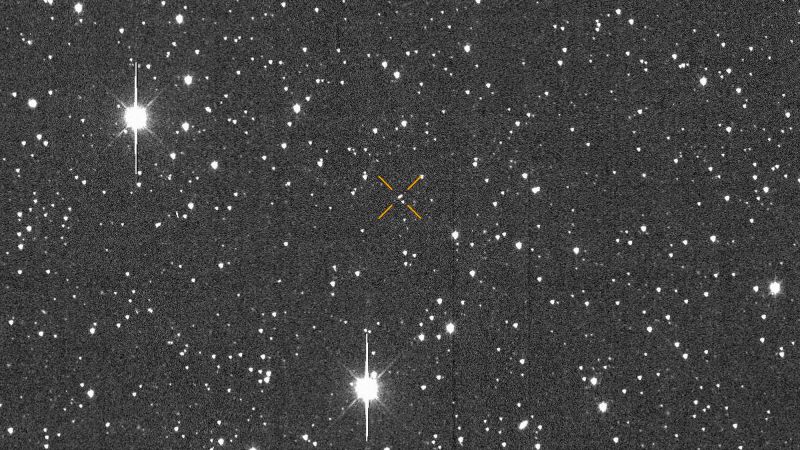
Subscribe to CNN’s Wonder Theory science newsletter.Dive into the universe with updates on remarkable discoveries, scientific progress, and more.
CNN
—
According to NASA and the European Space Agency, the asteroid 2024 YR4, which was labeled the most dangerous asteroid known just last week, now faces nearly zero probability of impacting our planet in 2032.
NASA has assessed that there is a 0.0017% likelihood of the asteroid colliding with Earth in December 2032, while the ESA’s estimate places it at 0.002%.
This translates to a chance of about 1 in 59,000 for an impact, indicating a 99.9983% probability that asteroid 2024 YR4 will safely bypass Earth in the next seven years, as per NASA. The agency also reported that further observations indicate a 1.7% chance the asteroid may hit the moon, but this poses no threat to Earth.
“Upon its discovery, asteroid 2024 YR4 exhibited a minor yet considerable chance of impacting our globe in 2032,” the agency noted on Monday.
“With further observations forwarded to the Minor Planet Center, scientists at NASA’s Jet Propulsion Laboratory were able to refine the asteroid’s trajectory models and now conclude there’s no significant risk of this asteroid colliding with Earth for the next hundred years. Recent data has also lessened the uncertainty regarding its future path, moving the potential locations of the asteroid on December 22, 2032, further away from our planet.”
Over the past weekend, 2024 YR4 also plummeted to a rating of 0 out of 10 on the Torino Impact Hazard Scale, which categorizes the risks of potential space object collisions with Earth. A score of zero denotes “the chance of a collision is non-existent or so minuscule as to be virtually nil. This applies to minor objects like meteors and those that burn up in the atmosphere, along with rare meteorite events that seldom cause damage.”
Detected on December 27, 2024, asteroid 2024 YR4 is estimated to be between 131 and 295 feet (40 to 90 meters) wide, akin to a large building, and could result in significant localized damage if it were ever to impact our planet.
The rapid reduction in the asteroid’s risk factor reflects the “dedicated and meticulous efforts of astronomers” who have consistently monitored the asteroid with telescopes worldwide, remarked Richard Binzel, creator of the Torino Scale. Binzel is also a professor of planetary sciences and an esteemed faculty member at the Massachusetts Institute of Technology’s aerospace engineering division.
“I’m pleasantly astonished by how quickly we managed to lower the probability figures,” said Binzel. “Having this uncertainty linger for long wouldn’t have been beneficial, as it was destined to decline to zero. Essentially, it’s either zero if it misses Earth or one if it hits; any figure in between is just the space of our uncertainty. We were eager to avoid prolonged uncertainty.”
Early last week, 2024 YR4 temporarily surpassed a record previously held by the asteroid Apophis after its initial observation in 2004.
During its highest threat level, 2024 YR4 was rated a 3 on the Torino Scale with a collision probability of approximately 3.1% by NASA, compared to the ESA’s estimate of 2.8%.
The slight variations stemmed from the different methodologies employed by the two agencies to calculate the asteroid’s trajectory and assess the collision probabilities. However, both projected probabilities surpassed the 2.7% collision likelihood earlier associated with Apophis, establishing 2024 YR4 as the most significant newly identified asteroid in the last twenty years.
As seen with Apophis, scientists anticipated that 2024 YR4 would initially exhibit elevated risk levels before ultimately diminishing as more observational data became available.
Measuring an impressive 1,148 feet (350 meters) in diameter, Apophis was previously categorized as one of the most perilous asteroids, with a substantial possibility of striking Earth, reaching a 4 out of 10 on the Torino Scale. This rating indicated that astronomers needed to pay attention to and monitor the asteroid closely. Apophis earned a 4 due to its size, capable of causing regional damage, while 2024 YR4 was assigned a 3, implying potential local damage, as explained by Binzel.
However, akin to 2024 YR4, Apophis also swiftly dropped from a 4 to a 0 on the Torino Scale after astronomers reviewed past observations, which allowed for a clearer understanding of its orbit. While Apophis is still on course for a close approach to Earth in 2029, which will be observed by various spacecraft, it doesn’t pose any risk to Earth in this century.
One of the major challenges astronomers face when evaluating the risk from newly identified asteroids is dealing with various uncertainties. For 2024 YR4, this encompasses determining the asteroid’s dimensions as well as its orbit.
Observations made during dark sky conditions, which allow ground-based telescopes to effectively track faint and small asteroids post the bright full moon on February 12, significantly expedited the reduction of the risk rating for 2024 YR4.
Prominent telescopes involved in this research include the Canada-France-Hawaii Telescope, Subaru Telescope, and Haleakala-Faulkes Telescope North, all situated in Hawaii, along with New Mexico’s Magdalena Ridge Observatory, the Gemini South Observatory in Chile, Arizona’s Lowell Discovery Telescope, and the Nordic Optical Telescope in the Canary Islands.
“The atmospheric conditions above Maunakea are typically very stable, which allows telescopes to produce exceptionally sharp images, often surpassing those from other observatory locations,” stated David Tholen, an astronomer at the University of Hawaii’s Institute for Astronomy.
The timing of the reduced impact likelihood for 2024 YR4 is fortunate. Astronomers had concerns as the asteroid’s trajectory would carry it away from Earth in a linear path, making it beyond the reach of ground-based telescopes in April, only to return to visibility in June 2028.
Nevertheless, scientists plan to continue monitoring this space rock to ensure that 2024 YR4 remains a non-threat, and the James Webb Space Telescope is scheduled to track the asteroid in early March to gather more information regarding its orbit and precise size.









